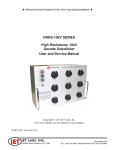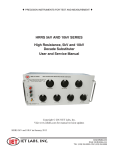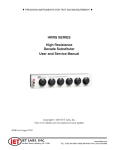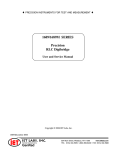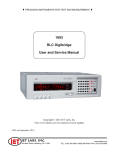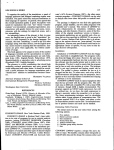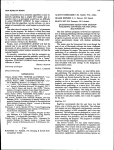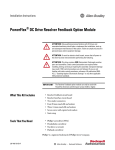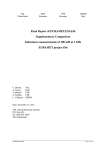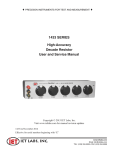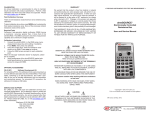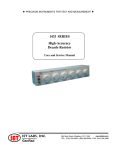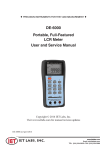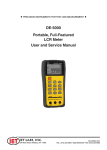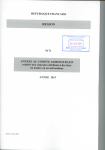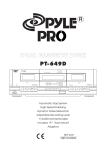Download Manual - IET Labs, Inc.
Transcript
♦ PRECISION INSTRUMENTS FOR TEST AND MEASUREMENT ♦ HACS-Z-A-7E-1pF Decade Capacitance System User and Service Manual Copyright © 2010 IET Labs, Inc. Visit www.ietlabs.com for manual revision updates HACS-Z-A-7E-1pF im/April 2010 IET LABS, INC. Long Island, NY • Email: info@ietlabs.com www.ietlabs.com TEL: (516) 334-5959 • (800) 899-8438 • FAX: (516) 334-5988 ♦ PRECISION INSTRUMENTS FOR TEST AND MEASUREMENT ♦ IET LABS, INC. Long Island, NY • Email: info@ietlabs.com www.ietlabs.com TEL: (516) 334-5959 • (800) 899-8438 • FAX: (516) 334-5988 HACS-Z-A-7E-1pF Contents Chapter 1 Introduction...............................................................................1 1.1 General Description............................................................................................... 1 1.2 Switches................................................................................................................. 2 1.3 Double Shielded Construction............................................................................... 2 Chapter 2 Specifications............................................................................3 Specifications ................................................................................................................. 3 Double Shielded Construction ....................................................................................... 3 Chapter 3 Operation...................................................................................5 3.1 Initial Inspection and Setup................................................................................... 5 3.2 Switch Setting........................................................................................................ 5 3.3 Connection to Terminals........................................................................................ 5 Chapter 4 Maintenance..........................................................................................7 4.1 Preventive Maintenance......................................................................................... 7 4.2 Calibration Interval................................................................................................ 7 4.3 Considerations for Calibration............................................................................... 7 4.4 Calibration Procedure............................................................................................ 8 4.5 Capacitance Adjustment......................................................................................... 8 4.5.1 Adjusting 1 pF - 1,000 pF decades.............................................................. 8 4.5.2 Adjusting 0.01 µF - 1 µF decades................................................................ 9 4.6 Replaceable Parts................................................................................................... 10 Table of Contents iii HACS-Z-A-7E-1pF Figures and Tables Figure 1-1: HACS-Z-7E-1pF...........................................................1 Figure 1-2: Capacitance Shunted by Leakage to case................................2 Figure 1-3: HACS-Z Construction................................................................2 Table 2-1: Specifications..............................................................................3 Figure 2-1: Double Shielded Construction...................................................3 Figure 2-2: Typical Operating Guide Affixed to HACS-Z-7E-1pF........................4 Figure 3-1: Capacitance Shunted by Leakage to case................................5 Figure 3-2: HACS-Z Construction ...............................................................6 Table 4-1: Capacitor type.............................................................................8 Figure 4-1: Calibration access holes............................................................8 Figure 4-2: Screws holding the internal housings........................................9 Figure 4-3: 0.01 µF & 0.1 µF capacitance sets............................................9 Figure 4-4: 1µF Capacitance Set.................................................................9 Table 4-2: Replaceable Parts List.................................................................10 Figure 4-5: Replaceable Parts......................................................................10 iv Table of Contents HACS-Z-A-7E-1pF Chapter 1 INTRODUCTION 1.1 General Description The HACS-Z-7E-1pF Decade Capacitance System is capable of meeting exacting requirements for fixed or adjustable calibration capacitance or any applications requiring precise stable capacitance values. Unit Features: • Range: 1 pF - 11.111 11 µF • Low zero-capacitance • High accuracy • Excellent stability • Low temperature coefficient • High voltage rating 1 pF, 10 pF decades For these, the lowest decade steps, trimmable air capacitors are used. The capacitors are selected for maximum resolution, high mechanical stability, and low dissipation factor. 100 pF - 0.1 µF decades These mid-range decades are implemented with the highest grade, mechanically stabilized, sealed India ruby mica capacitors selected for optimum electrical characteristics and low dissipation. They are hermetically sealed to prevent intrusion of moisture and to obtain minimum drift. 1 µF decade This decade is implemented with metallized polyphenylene sulfide (MPPS). These capacitors are hermetically sealed for high reliability and stability. Hermetic sealing prevents the intrusion of moisture into the capacitor packages, and results in minimum drift. Figure 1-1: HACS-Z-7E-1pF Introduction Stability The stability of the capacitors is such that the instrument should not require readjustment for the duration of the recommended calibration interval. Should recalibration become necessary, easily accessible trimmer capacitors are provided for the l pF, 10 pF, 100 pF, and 1000 pF decades. The other decades may also be calibrated with discrete padder capacitors. 1 HACS-Z-A-7E-1pF 1.2 Switches Custom-designed switches are used to connect four capacitors in a parallel circuit for each decade. These are weighted in a 1-2-2-5 code to provide all the necessary combinations for ten equal steps for each decade. The switch circuit is designed such that each unused capacitor is completely disconnected from the rest of the circuit and has its positive terminal connected to the inner shield. See Figure 1-3. shield shunts this capacitance when it is electrically connected to the outer shield, forming a 3-terminal capacitor (5-teminal capacitor for units with 10 µF steps or higher). All unused capacitors are shorted to this inner shield at their high ends, and are open at their low ends. This inner shield is not actually an internal enclosure but rather a cellular structure that optimally separates all conductors and capacitor elements. It also serves to minimize terminal-to-ground capacitance which is necessary when measuring small capacitances with various bridges. The stability of the switches is assured by the use of large gaps and secure mechanical construction. 1.3 Double Shielded Construction In order to meet the low residual capacitance requirement, the unit utilizes: • Specially shielded and routed wiring • The switching scheme described above and shown in Figure 1-2 • A double-shielded construction to keep the zero capacitance at an extremely low level Figure 1-2 demonstrates the need for the double shielded construction. It shows that a capacitor CHL would be shunted by the series combination of the series combination of the capacitances from the HIGH and LOW terminals to the case. The net capacitance becomes: Figure 1-2: Capacitance Shunted by Leakage to case CHL + (CHG in series with CLG) Clearly it would be very difficult to get a very low residual or zero capacitance, unless the G terminal is the ground terminal of 3-terminal measurement of the capacitance. Figure 1-3: HACS-Z Construction In order to accomplish this, an inner shield is added as conceptually shown in Figure 1-3. It is mechanically constructed to shunt away any capacitance between the HIGH and LOW terminals. This inner 2 Introduction HACS-Z-A-7E-1pF Chapter 2 SPECIFICATIONS For convenience to the user, the pertinent specifications are given in an Operating Guide, similar to the one shown in Figure 2-2, which is affixed to the case of the instrument. SPECIFICATIONS Capacitance per step Total decade capacitance 1 pF 10 pF 1 pF 100 pF 100 pF 1 nF Max voltage Dissipation factor* Accuracy* Stability Capacitor type <0.002 Air capacitors Position 1: <0.002 All others: <0.001 Position 1: <0.001 Position 2: <0.0005 500 V peak max up to 10 kHz ± (0.05% + 0.5 pF) All others: <0.0003 1,000 pF 10 nF 0.01 µF 100 nF <0.0003 0.1 µF 1 µF <0.0004 1 µF 10 µF 50 V peak max ±(200 ppm + 0.1 pF) per year <0.0010 Silvered mica Mechanically stabilized <0.0003 Hermetically sealed ±500 ppm per year Sealed metallized polyphenylene sulfide (MPPS) *Bottom terminals for all decades 1 kHz, 3-terminal measurement; series model; 1 Vrms, 23°C; traceable to SI No zero-subtraction required Table 2-1: Specifications Range: 0 to 11.111 110 µF, in 1 pF steps Dimensions: 54 cm W x 32 cm H x 33 cm D (21” x 12.5” x 13”) Zero Capacitance: ≤0.1 pF maximum capacitance obtained with all dials set to zero; Weight: 23 kg (51 lbs) Temperature Coefficient: 1 pF - 0.1 µF decades: ≈20 ppm/°C 1 µF decade: -50 ppm/°C Connection to Capacitor: Four bnc connectors labeled HI and LO located on the front. The shielding is divided into the following parts: The inner shield: minimizes the terminal-to-guard capacitance Outer shield (the case): minimizes the detector input capacitance and noise The outer shells of the HI connectors are connected to the switch shaft. The outer shells of the LO connectors are connected to the outer case. To use the HACS-Z as a 3-terminal capacitance substituter with very low zero-capacitance connect the two shields together at the measuring instrument. Insulation Resistance: >50,000 MΩ Operating Temperature Range: 10°C to 40°C Shielding: Double-shielded construction; see below. DOUBLE SHIELDED CONSTRUCTION The shielding is divided into two different parts: an inner shield that minimizes the low terminal-to-guard capacitance, and an outer shield (the case) that minimizes the detector input capacitance and noise. (See Figure 2-1.) When these two shields are connected together, the HACS-Z becomes an excellent 3-terminal capacitance substituter with low zero capacitance. Specifications HI Inner Shield LO CHL Outer Case Figure 2-1: Double Shielded Construction 3 HACS-Z-A-7E-1pF 1 pF 1 nF 100 pF 10 p F 500 V pe ak m ax u p t o 10 k H z M ax vo ltag e ± (0.0 5%+ 0.5 pF ) A ccu r acy* <0 .0010 <0 .000 4 <0 .000 3 <0 .000 5 Po sit io n 1: <0 .0 0 2 A ll o t her s: <0 .0 0 1 Po sit io n 1: <0 .0 0 1 Po sit io n 2 : <0 .0 0 0 5 A ll o t her s: <0 .0 0 0 3 <0 .002 Dis s ip atio n facto r * ±(200 pp m + 0.1 pF ) pe r ye ar Stab ility CONSULT INSTRUCTION MANUAL FOR PROPER INSTRUMENT OPERATION 10 p F 10 n F 50 V pe ak m ax SN: H1-1015332 S ea led m e t a lized po lyp hen ylen e s ulf ide (M P P S ) S ilv e re d m ic a M ec han ic a lly s t ab ilized H e rm et ic a lly s e ale d A ir c a pa c it o rs C ap acito r typ e HACS-Z-A-7E-1pF HIGH ACCURACY DECADE CAPACITANCE SUBSTITUTER 100 p F 100 nF T o tal d e cad e cap acitan ce 1,000 p F 1 µF C ap acitan ce p e r s te p 0.01 µF Range: 0 to 1.111,10 µF, in 1 pF steps Temperature coeficient: ≈20 ppm/°C 0.1 µF Zero capacitance: <0.1 pF maximum capacitance obtained when all dials are set to zero Insulation resistance: >50,000 MΩ 1 µF 10 µ F Operating temperature range: 10°C to 40°C MODEL: HACS-Z-A-7E-1pF The outer shell of the HI connector is connected to the switch shaft. The outer shell of the LO connector is connected to the outer case. To make the HACS-Z a 3-terminal capacitance substitutor with very low zero-capacitance, connect these two shields together at the measuring instrument No z ero s ubtrac tion required * 1kHz , 3-terminal meas urement; s eries model; 1 V rms ; trac eable to SI Connection to capacitor: Two bnc connectors labeled HI and LO are located on the front panel. The shielding is divided into the following parts: The inner shield: minimizes the terminal-to-guard capacitance The outer shield (the case): minimizes the detector input capacitance and noise WARNING www.ietlabs.com HACS-Z lbls/p1/HACS-Z-B-6E-1pF-TMDE/06-16-09/80% • 534 Main Street, Westbury, NY 11590 • (516) 334-5959 • Fax: (516) 334-5988 Observe all safety rules when working with high voltages or line voltages. Connect the (G) terminal to earth ground in order to maintain the case at a safe voltage. Whenever hazardous voltages (>45 V) are used, take all measures to avoid accidental contact with any live components: a) Use maximum insulation and minimize the use of bare conductors. b) Remove power when adjusting switches. c) Post warning signs and keep personnel safely away. IET LABS, INC. CAGE CODE: 62015 Figure 2-2: Typical Operating Guide Affixed to HACS-Z-7E-1pF Specifications 4 HACS-Z-A-7E-1pF Chapter 3 OPERATION 3.1 Initial Inspection and Setup 3.3 Connection to Terminals This instrument was carefully inspected before shipment. It should be in proper electrical and mechanical order upon receipt. In order to properly use the HACS-Z capacitor, it is necessary to understand the use and function of each of the capacitor terminals. Refer to Figure 3-1 and note that a basic capacitor is a 2-terminal capacitor shown as CHL. As described above, CHG and CLG, the capacitances to the case add to the capacitor CHL unless the 3rd terminal G is connected to the guard of the measuring instrument. An OPERATING GUIDE, shown in Figure 2-2, is attached to the case of the instrument to provide ready reference to specifications. 3.2 Switch Setting The HACS-Z Precision Capacitor has six capacitance decades. The actual capacitance for each decade is the product of the switch setting and the CAPACITANCE PER STEP indicated below each switch on the front panel. Note, however, that if any dial is set on 10, a 1 is added to the next decade. For example, if the dials are set: to 10-9-9-10-1-1, the resultant capacitance is: 1 1 10 9 9 10 Total 1100011 pF Figure 3-1: Capacitance Shunted by Leakage to case The zero capacitance of the HACS-Z unit is very low, but all settings are adjusted to accurately provide their nominal values, and it is not necessary to subtract the zero capacitance from any particular setting Operation 5 HACS-Z-A-7E-1pF The shielding is divided into two different parts: an inner shield that minimizes the low terminal-toguard capacitance, and an outer shield (the case) that minimizes the detector input capacitance and noise. See figure 3-2. When these two shields are connected together, the HACS-Z becomes an excellent 3-terminal capacitance substituter with low zero capacitance. Using the unit as a 2-terminal capacitor will cause an error of about 100 to 150 pF to be added. This error is not necessarily the same for every setting. This also makes the unit susceptible to noise. However, for high capacitance, the unit may be used as a 2-terminal device. Figure 3-2: HACS-Z Construction 6 Operation HACS-Z-A-7E-1pF Chapter 4 MAINTENANCE 4.1 Preventive Maintenance 4.3 Considerations for Calibration Keep the unit in a clean environment. This will help prevent possible contamination. It is important, whenever calibrating the HACS-Z unit, to be very aware of the capabilities and limitations of the test instruments used. The HACS-Z is packaged in a closed case, which limits the entry of contaminants and dust into the instrument. If it is maintained in a clean or air-conditioned environment, cleaning will seldom be required. In a contaminated atmosphere, cleaning may be required. To clean the front panel, wipe the front panel using alcohol and a lint-free cloth. 4.2 Calibration Interval The recommended calibration interval for the HACS-Z Capacitance Substituter is twelve (12) months. The calibration procedure may be carried out by the user if a calibration capability is available, by IET Labs, or by a certified calibration laboratory. If the user should choose to perform this procedure, then the considerations below should be observed. Maintenance Recommended Instruments: • IET Model 1689 Digibridge (direct reading) or • IET Model 1620 or 1621 Precision Capacitance Measurement System (bridge) The test instruments must be significantly more accurate than ±(0.05% + 0.5 pF) for all ranges, allowing for a band of uncertainty of the instrument itself. It is important to allow both the testing instrument and the HACS-Z to stabilize for a number of hours at the nominal operating temperature of 23OC, and at nominal laboratory conditions of humidity. There should be no temperature gradients across the unit under test. BNC test terminals should be used to obtain accurate shielded readings. 7 HACS-Z-A-7E-1pF 4.6 Replaceable Parts Model Ref IET Pt No Description 1 0505-4030 Mica Capacitor, 100 pF 1 0505-4031 Mica Capacitor, 200 pF 1 0505-4032 Mica Capacitor, 500 pF 1 0505-4033 Mica Capacitor, 1 nF 1 0505-4034 Mica Capacitor, 2 nF 1 0505-4035 Mica Capacitor, 5 nF 1 0505-4036 Mica Capacitor, 10 nF 1 0505-4037 Mica Capacitor, 20 nF 1 0505-4038 Mica Capacitor, 50 nF 1 0505-4039 Mica Capacitor, 100 nF 1 0505-4040 Mica Capacitor, 200 nF 1 0505-4041 Mica Capacitor, 500 nF 2 4380-3700 Air Capacitor, 2.7-19.6 pF 3 4380-3600 Air Capacitor, 1.7-8.7 pF 4 4380-3500 Air Capacitor, 1.5-5.0 pF 5 HACS-Z-520033 Switch Assembly 6 HACS-Z-4300-KNB Knob Assembly Not Visible HACS-Z-1µF 1 µF assembly Not Visible HACS-Z-PE4091 HIGH bnc connector Not Visible HACS-Z-31-221-RFX LOW bnc connector Not Visible 1413-BC-14215 Bail assembly Table 4-2: Replaceable Parts List 2 1 3 4 5 6 Figure 4-5: Replaceable Parts 10 Maintenance HACS-Z-10E-1pF 11














